Imperfect wood is now a key part of interior design and furniture making. It brings a natural touch to any room. The unique features of wood, like knots in wood and grains in wood, make each piece special.
The charm of imperfect wood comes from its rough finishes and natural imperfections. This trend shows our love for authenticity and nature. So, wood with unique wood characteristics is very popular.
In this article, we’ll dive into the beauty of imperfection in wood. We’ll see why it’s so timeless.
The Changing Perception of Wood Imperfections
How we see wood imperfections has changed a lot. This change comes from new tastes and design trends. Before, the wood industry graded wood based on how perfect it was. The higher the grade, the fewer the defects.
Historical Perspective on Wood Grading
Wood grading used to mean picking wood without any flaws. This was because people wanted wood products to be perfect and the same.
The Shift in Consumer Preferences
But now, people want wood with its own unique marks. They love the natural wood beauty and rustic wood charm that comes with it.
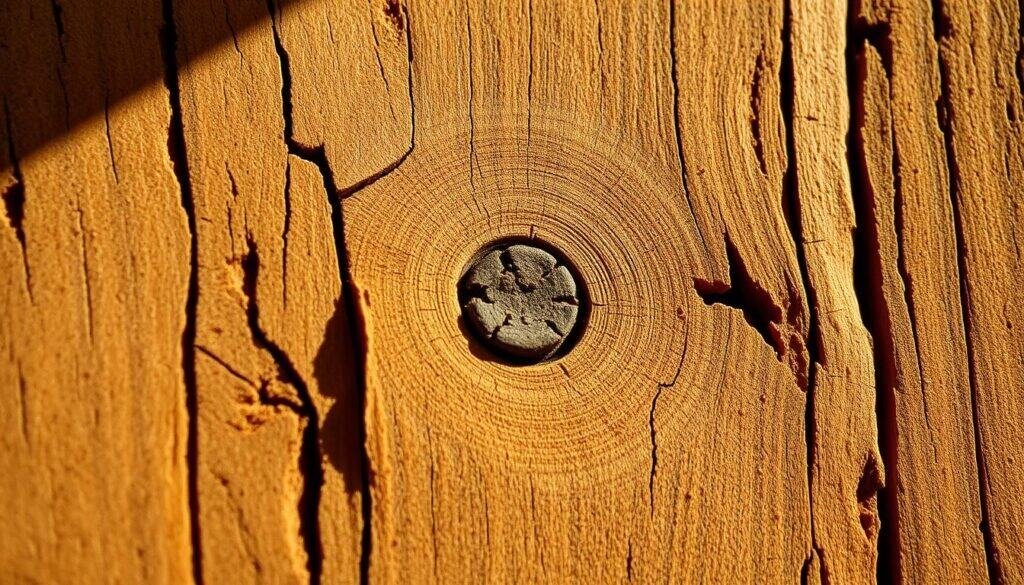
Farmhouse and industrial styles have made this shift even bigger. These styles love the organic wood textures and the marks they bring. They make furniture and decor more interesting.
Reaction to Mass-Produced Perfection
People are also tired of mass-produced perfection. They want wood with its own special marks, or wood imperfections. This adds realness to their homes.
This change shows we value the beauty and uniqueness of wood imperfections more. It shows we understand what makes wood truly special.
The Beauty of Imperfection: Why Knots, Grains, & Rough Finishes Make The Wood
Knots, grains, and rough finishes are not just flaws; they’re what make wood special. Each piece of wood has its own unique mark, thanks to its natural traits.
The Unique Fingerprint of Each Piece
The natural wood texture, with its varied grain and knots, means no two woods are the same. This uniqueness is what makes each wood item special, making it one-of-a-kind.
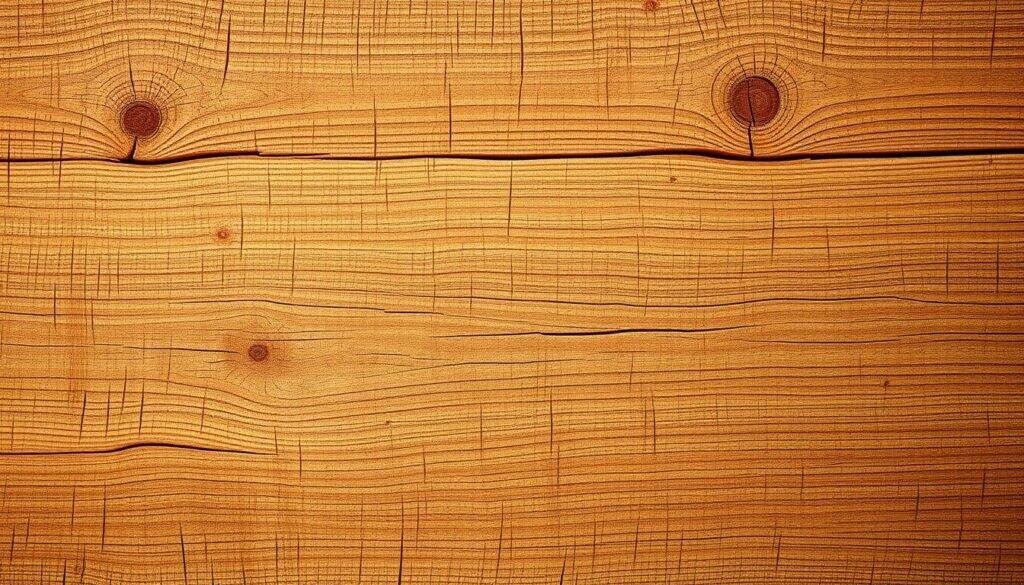
The wood grain texture and other imperfections create a fascinating pattern. This pattern can add character to any room. The rustic wood texture, in particular, brings warmth and coziness.
Reading the History of a Tree
Looking at a piece of wood, we see more than just a material. We see the history of a tree that grew over years, sometimes decades or even centuries. The rings, knots, and other features tell the tree’s life story.
Connecting with Nature Through Wood’s Biography
By appreciating wood’s texture design and natural features, we connect with nature. We remember the tree’s journey from seed to maturity. This connection is deeply satisfying.
Using wood with imperfections in our homes and furniture adds beauty and value. It brings a piece of nature indoors. The natural beauty of wood, with its unique traits, enhances our living spaces, creating warmth and authenticity.
Understanding Wood Knots: Nature’s Artistic Signatures
Knots in wood are not just flaws; they are nature’s artistic marks that add depth and character. Wood knots have long fascinated craftsmen and designers. They bring unique patterns and natural beauty to wood.
Live Knots vs. Dead Knots
Wood knots are divided into live and dead knots, each with its own traits. Live knots form when a branch is connected to the tree. They are usually lighter in color and blend well with the wood.
Dead knots, by contrast, come from branches that have died and fallen off. They are darker and sometimes loose. The difference between live and dead knots makes wood textures and colors varied, making each piece unique.
How Branch Growth Creates Knot Patterns
The way branches grow around the trunk creates unique knot patterns in wood. As a branch grows, it gets trapped in the trunk, forming a knot. The size, shape, and frequency of these knots depend on the tree’s growth and the environment.
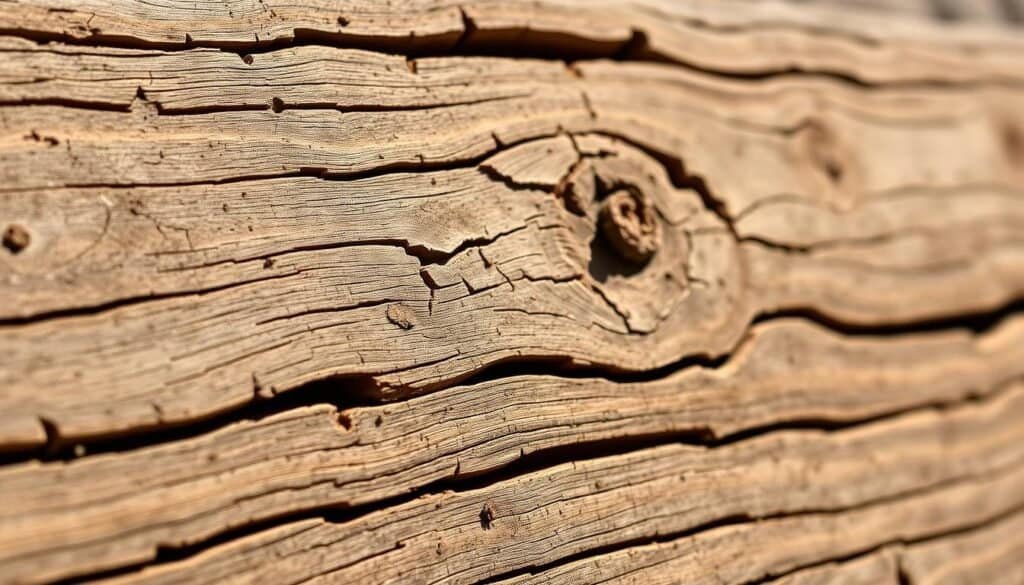
Knots often create striking color contrasts in wood, drawing the eye and creating natural focal points. The color difference between the knot and the surrounding wood can vary from subtle to dramatic, adding visual interest.
Knots as Natural Design Elements
Designers and craftsmen often use knots as natural design elements. They create visually appealing patterns and textures. By embracing knots, woodworkers can make pieces that show the wood’s inherent beauty.
In conclusion, wood knots are a key feature of natural wood. They offer a range of textures, colors, and patterns that enhance its beauty.
The Mesmerizing World of Wood Grain Patterns
Every piece of wood has a unique grain pattern. This pattern is shaped by the tree’s growth and the environment. These patterns are not just pretty; they also tell the wood’s story.
Annual Rings and Growth Patterns
The grain pattern in wood comes from the annual rings. Each ring shows one year of growth. The width and texture of these rings vary, creating different patterns.
Environmental Factors Affecting Grain
Things like climate, soil, and sunlight impact the grain pattern. For example, a tree in tough conditions might have a more unique grain.
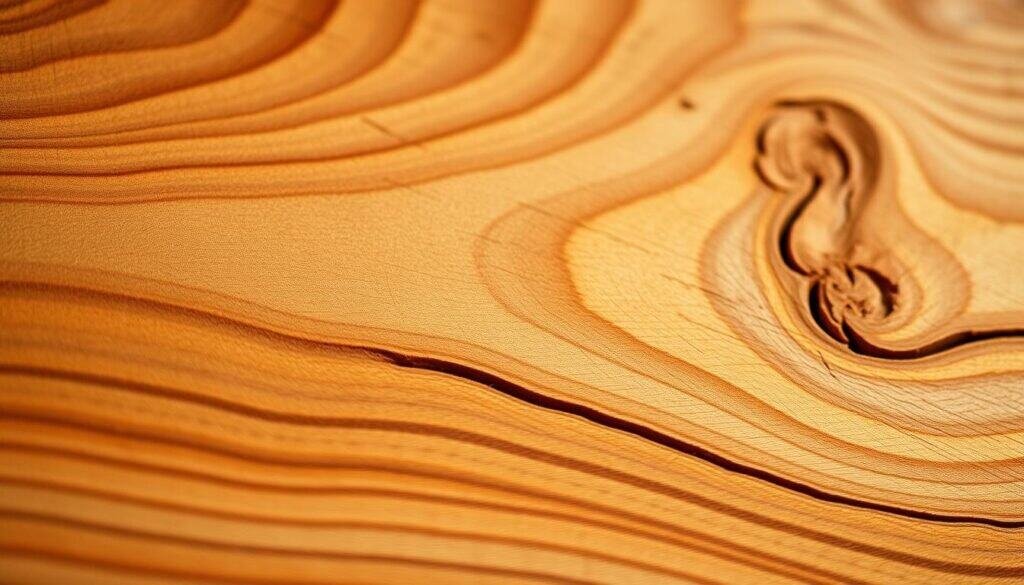
Some woods, like oak, walnut, and maple, have striking grain patterns. Oak has a clear ring pattern, while walnut is known for its dark, rich grain.
Exotic Wood Grain Characteristics
Exotic woods have unique grain patterns that designers love. These patterns add beauty and character to wood products.
The natural wood grain is key in wood design. It offers many textures and patterns. These enhance the look of any wood product, from simple cutting boards to complex furniture.
Rough Finishes: Celebrating Wood’s Tactile Nature
Rough finishes are now a key part of modern woodwork. They highlight the unique feel of wood. The texture of wood adds to its beauty and how it feels.
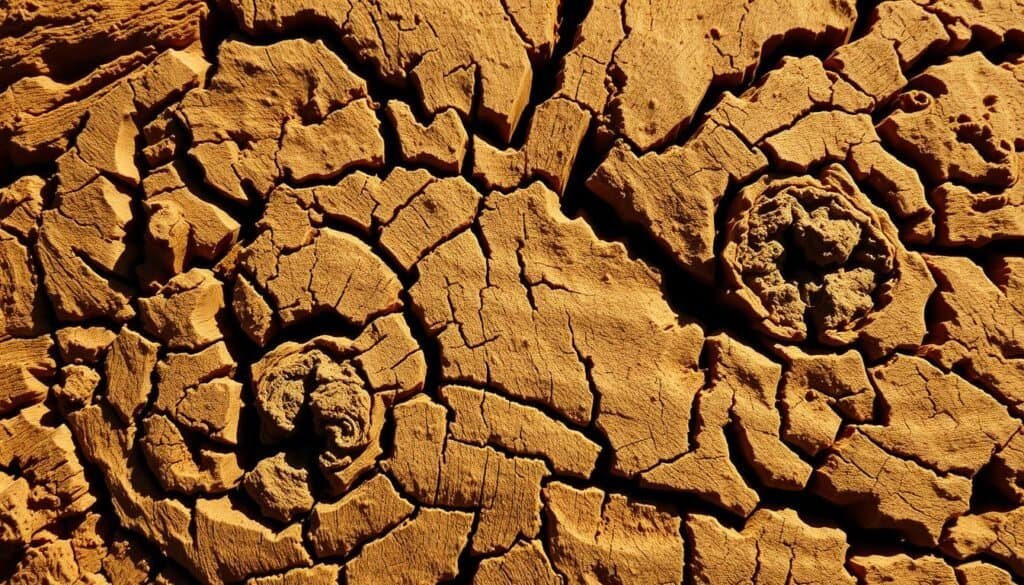
Wire-brushed and distressed surfaces are big in rough finishes. Wire brushing uses a wire brush to take off soft wood fibers. This leaves the harder fibers and makes a textured look. Distressing makes the wood look worn by using sanding or chiseling.
Hand-Scraped and Saw-Marked Textures
Hand-scraped textures come from scraping the wood with a tool. This creates unique patterns that make the wood special. Saw-marked textures keep the marks from the saw, showing the wood’s raw quality.
Touch and Perception of Authenticity
The feel of wood with rough finishes makes it seem real. When wood feels natural, it connects with us on an emotional level. The texture encourages us to touch it, making our experience with the wood more personal.
How Texture Affects Light Reflection
The texture of wood changes how light hits it. Rough textures scatter light, making the look more subtle. This is different from smooth surfaces, which reflect light evenly. The scattered light adds depth and interest to the wood, showing off its natural beauty.
In summary, rough finishes celebrate wood’s natural texture and flaws. Methods like wire brushing, distressing, hand scraping, and keeping saw marks make unique, genuine pieces. These pieces invite us to touch and appreciate them.
The Psychological Appeal of Imperfect Wood
There’s a deep connection between humans and imperfect wood. This is because of its natural look. Several factors make us appreciate the beauty of natural wood.
Evolutionary Preferences for Natural Elements
Humans naturally prefer natural things, thanks to evolution. Imperfect wood, with its unique features like knots, speaks to this preference. Its natural flaws make us feel connected to nature.
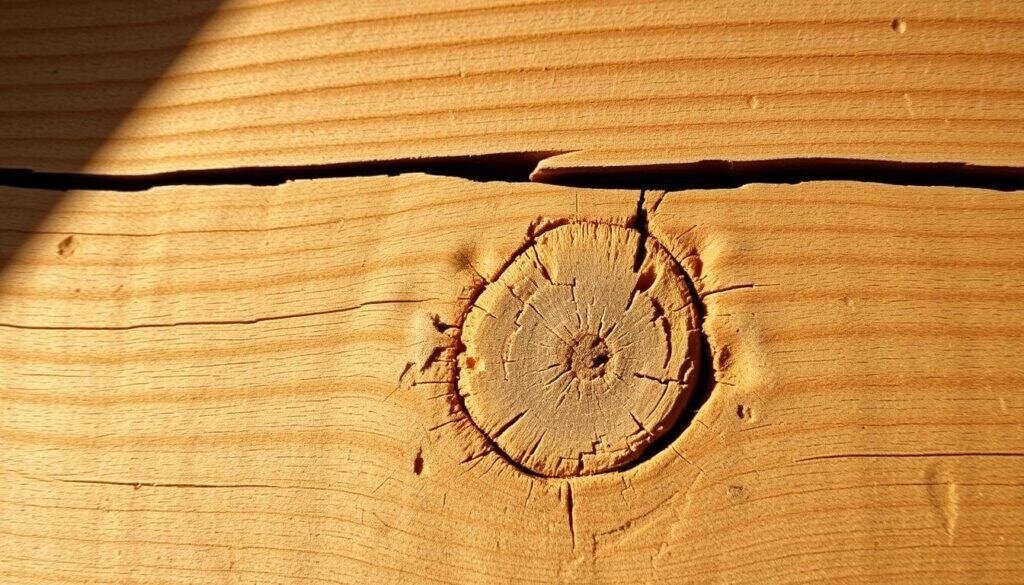
Being around natural materials like imperfect wood lowers stress. The unique texture of wood brings calm. Natural settings and materials make us feel peaceful and well.
Wabi-Sabi Philosophy in Wood Appreciation
The Wabi-Sabi philosophy values imperfection. It’s a Japanese way of seeing beauty in the imperfect and aged. Imperfect wood shows the spirit of Wabi-Sabi with its unique story.
Relief from Perfection Pressure
In a world chasing perfection, imperfect wood is a relief. It shows that flaws make something special and unique. Accepting imperfection frees us from the need for perfection.
Imperfect wood connects us to nature, lowers stress, and celebrates uniqueness. Embracing natural wood beauty and its texture improves our surroundings and well-being.
Imperfect Wood in Interior Design
Imperfect wood adds depth and texture to rooms. It makes a house feel like a home, welcoming and lived-in.
Contrast with Sleek Contemporary Elements
Pairing imperfect wood with sleek, modern pieces creates a stunning look. For example, a rustic wood coffee table with modern sofas balances old and new.
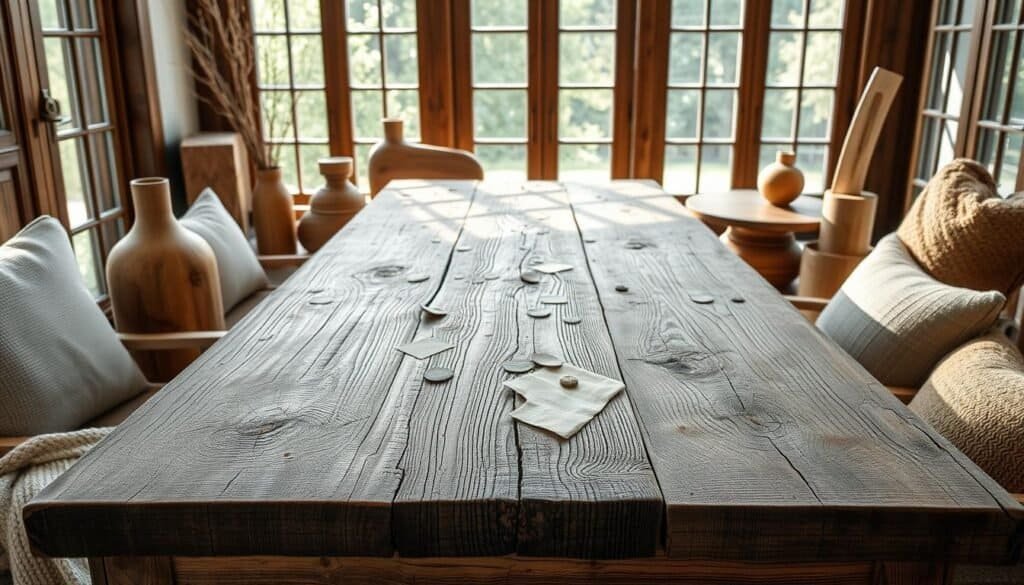
Imperfect wood makes great focal points in rooms. A dark wood accent wall or wooden beam ceiling grabs attention, becoming the room’s centerpiece.
The Modern Farmhouse Aesthetic
The modern farmhouse style loves imperfect wood for its cozy, rustic vibe. It features exposed beams, wooden floors, and reclaimed wood furniture. This mix of old and new is both charming and comfortable.
Mixing Wood Textures and Finishes
Mixing wood textures and finishes adds complexity and interest. Smooth, polished wood with rougher pieces creates a layered, dynamic look. It’s both sophisticated and inviting.
Using imperfect wood in design makes spaces beautiful and full of character. It adds warmth and charm, whether as a statement piece or part of a design theme.
Furniture That Tells a Story: Showcasing Wood’s Natural Beauty
Furniture made from wood with natural imperfections is more than just furniture. It’s a story waiting to be shared. Each piece of wood has its own unique traits, shaped by nature over time. These natural elements add authenticity and uniqueness to furniture design.
Tables, shelving, and headboards are great for showing off wood’s natural beauty. Craftsmen keep the tree’s natural form to highlight the wood’s charm. For example, a wooden table with a big knot can be a dining room’s centerpiece, adding warmth and character.
Tables, Shelving, and Headboards
Keeping the tree’s natural form preserves the wood’s original beauty. This method ensures the wood’s texture and grain patterns stay intact, making the furniture visually appealing. Barn wood and historical timber add even more to the story, as they often have their own histories.
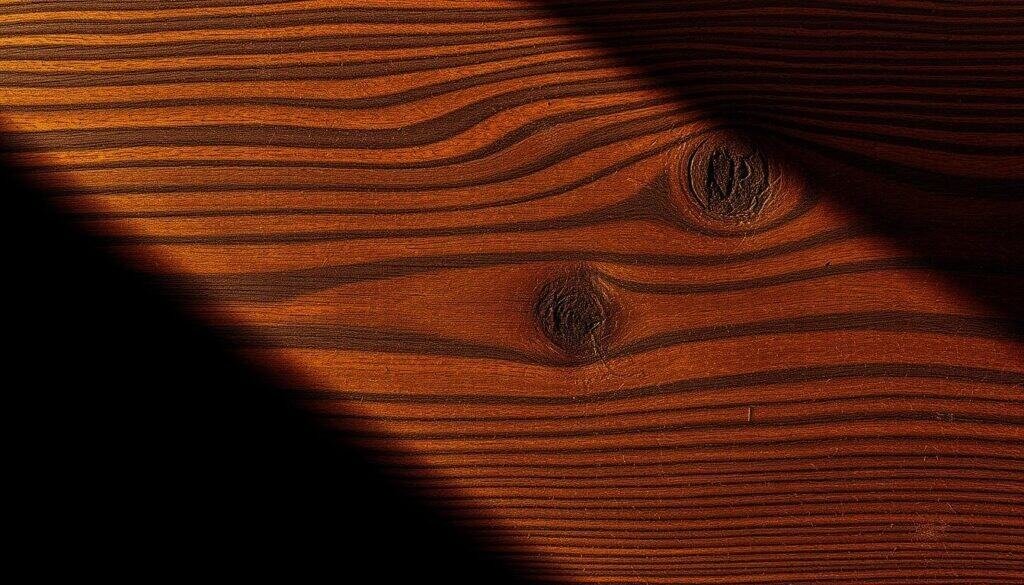
Barn wood and historical timber are loved for their unique patina and character. They’ve developed these over years of being exposed to the elements. Using these materials in furniture design adds beauty and tells a story of the wood’s past. The dark wood grain, rustic prints, and wood texture design all play a part in the piece’s narrative.
Patina and Character from Previous Use
The patina and character from previous use add depth to the furniture’s story. As wood ages, it gets a rich patina that shows its history. This aging process, along with the wood texture wallpaper effect some woods have, makes the furniture even more charming.
In conclusion, furniture made from imperfect wood celebrates nature’s craftsmanship. By embracing wood’s natural imperfections and unique traits, craftsmen create pieces that are beautiful and have their own stories.
Architectural Applications of Characterful Wood
Characterful wood is used in many ways in building design. It can be found in timber frames and as exterior siding. This lets architects and builders add unique, natural touches to buildings, making them more beautiful.
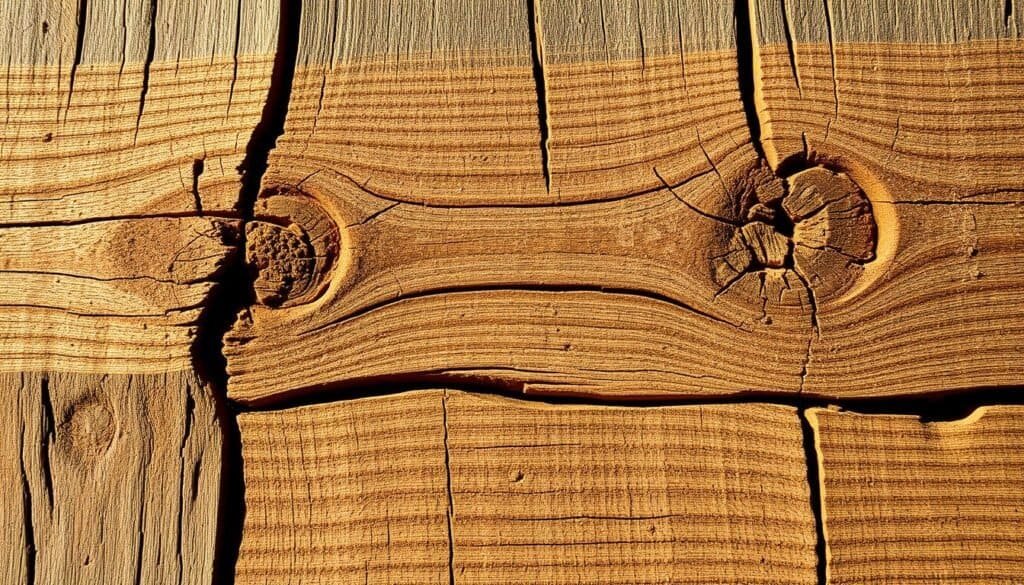
Timber frame construction is a traditional method that highlights the beauty of wood. Builders use large, solid timbers to create strong and visually appealing structures. The natural texture of the wood is fully shown off.
Retrofitting with Decorative Beams
Decorative beams can be added to existing spaces to bring in characterful wood. This adds warmth and character to interiors, using the rustic wood aesthetic effectively.
Weathered Wood Accent Walls
Weathered wood accent walls bring the outdoors inside. They use wood that has weathered to a soft, silvery gray. This creates a cozy, inviting atmosphere.
Exterior Siding with Natural Character
Wood siding with natural character can make a building look more appealing. The raw wood texture and pattern add depth and interest to the exterior.
Using characterful wood in building design lets builders and architects create structures that are both functional and tell a story. The natural beauty and imperfections of wood add to the charm of a building.
Techniques for Enhancing Wood’s Natural Character
Craftsmen use many techniques to bring out wood’s natural beauty. They apply special finishes to show off the wood’s texture.
Cerused and Limed Finishes
Cerused and limed finishes make the wood grain stand out. Cerusing uses white or light-colored wax to create a striking contrast. Liming uses a white pigment for a soft, silvery look. Both are great for woods like oak or ash.
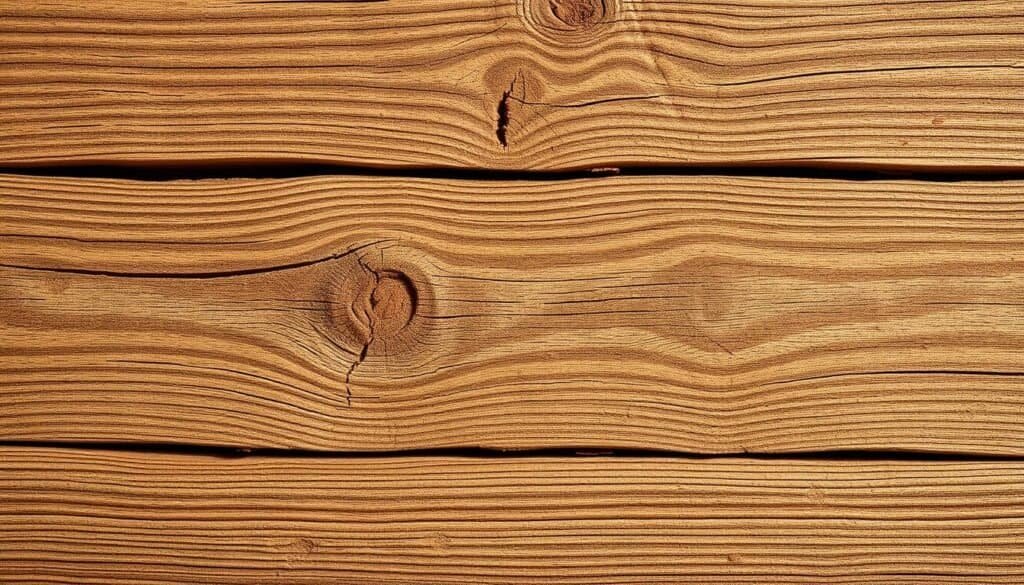
Choosing between oil and film finishes changes how wood looks. Oil finishes make the wood’s color and texture pop without a surface film. Film finishes, like polyurethane, protect the wood but might hide its texture.
Tools and Techniques for Adding Character
Craftsmen use tools and techniques to add character to wood. Hand scraping and wire brushing distress the wood, highlighting its grain. These methods give wood a unique, aged look.
Chemical Treatments for Aged Appearances
Chemical treatments can make wood look aged. Methods like ammonia fuming or wood stains add depth and complexity. These treatments enhance the wood’s natural beauty.
By using these techniques, craftsmen highlight wood’s natural beauty. Whether through cerused finishes, choosing the right finishes, or using specific tools and treatments, wood’s character shines through.
Sustainable Aspects of Embracing Imperfect Wood
Choosing imperfect wood is not just good-looking. It’s also eco-friendly. It helps cut down on waste in the wood industry. By using lumber with character, we reduce the waste from production.
Utilizing Character-Grade and “Flawed” Lumber
Character-grade lumber is full of natural beauty and unique traits. It’s a sustainable choice because it uses trees that might be thrown away because of looks.
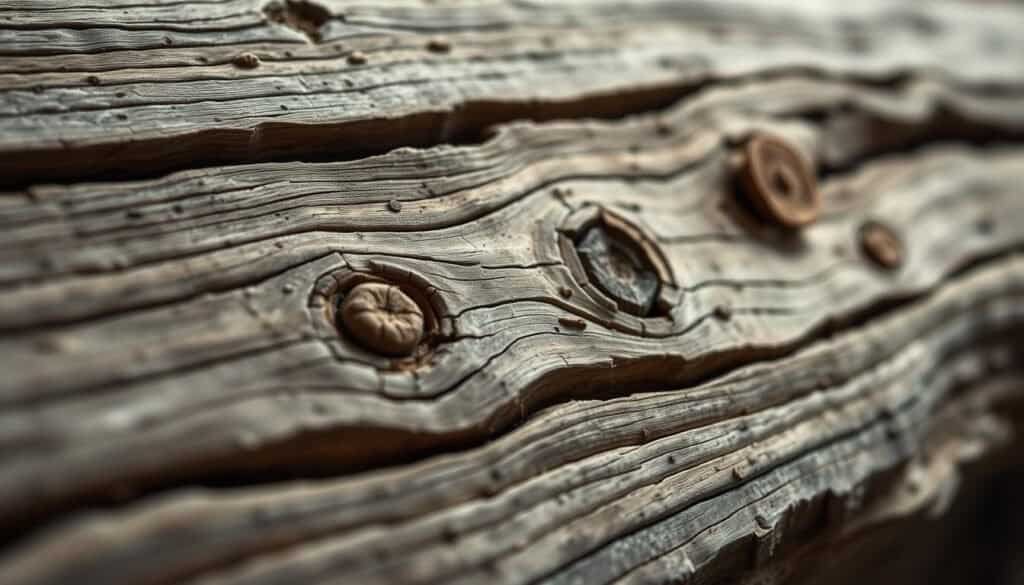
Whole-tree utilization means using as much of the tree as we can. This cuts down waste and makes the most of each tree. It’s better for the environment and celebrates the natural beauty of wood.
Forest Management Implications
Using imperfect wood changes how we manage forests. It values trees for their unique qualities, not just their looks. This leads to more diverse and strong forests.
Carbon Footprint Considerations
Using imperfect wood is better for the planet. It needs less energy to prepare and process. This lowers its carbon footprint.
In summary, embracing imperfect wood is good for the planet. It uses character-grade lumber, whole-tree utilization, and smart forest management. All these help reduce our carbon footprint.
Caring for and Maintaining Characterful Wood
The beauty of imperfect wood comes from its unique character. This can be kept alive with the right care. Wood with knots, grains, and rough finishes adds rustic charm to any space. But, to keep it looking great, knowing the right care is key.
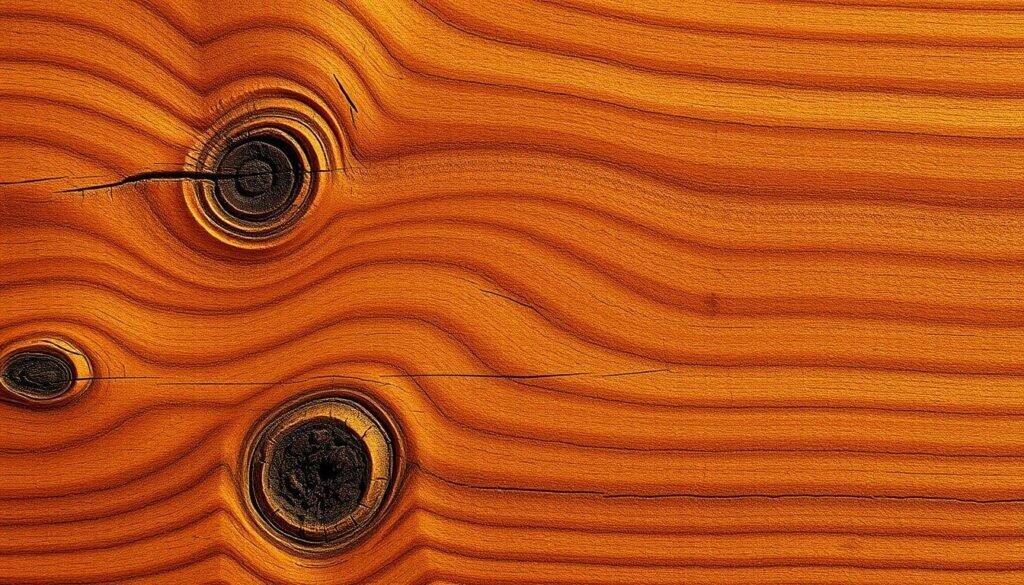
Cleaning this wood needs a soft touch. For textured surfaces, a soft-bristled brush helps remove dust. Stay away from harsh chemicals that can harm the wood or remove its natural oils. Instead, use a mild wood cleaner that keeps the wood’s texture and look.
Refinishing Without Losing Character
Refinishing characterful wood is a careful task. It’s important to keep the wood’s original charm while making it look better. Choose a refinishing product that fits the wood type, and apply it in thin layers to keep the wood’s natural look.
Structural vs. Aesthetic Considerations
When caring for characterful wood, balance is key. It’s important to keep the wood looking good and strong. Check the wood often for damage or wear, and fix any problems quickly.
Stabilizing Knots and Cracks
Knots and cracks are common in characterful wood. To fix these, use a wood stabilizer or filler that matches the wood’s color. This helps prevent more damage and makes the wood look better.
By following these care and maintenance tips, you can keep the unique charm of characterful wood. Enjoy its beauty for many years to come.
The Future of Imperfect Wood in Design and Craftsmanship
Technology and a love for realness are changing wood design. Digital tools are making imperfect wood even more special.
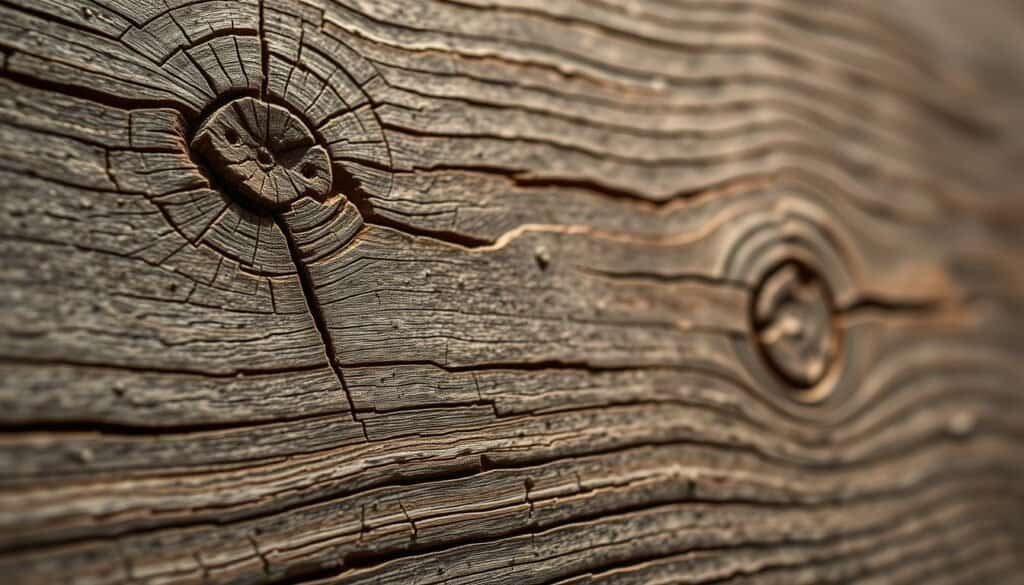
People want materials that have a story. Imperfect wood, with its unique look, is perfect for this.
Digital Design Tools for Unique Wood Features
These tools help craftsmen make designs that show off wood’s natural beauty.
3D Scanning of Unique Wood Features
This method captures wood’s texture and flaws. It makes custom pieces that celebrate the wood’s natural look. Plus,
CNC and Laser Applications for Character Wood
These technologies allow for detailed cuts and shapes. They make designs that were once impossible.
Together, these technologies are changing wood design. Craftsmen can now make pieces that show off imperfect wood’s beauty. They can also explore new possibilities in wood craftsmanship.
Conclusion: Embracing the Perfect Imperfection of Wood
The charm of imperfect wood comes from its unique character. This is shaped by nature’s detailed processes. We’ve seen how the beauty of imperfection, natural wood beauty, and wood characteristics make wood special.
By accepting wood’s imperfections, we celebrate its natural beauty. We also support sustainability and craftsmanship. Knots, grains, and rough finishes share the wood’s history and the natural world.
Designers, craftsmen, and consumers can appreciate wood’s value. This appreciation grows as we see wood’s uses in design and architecture.
The beauty of wood’s imperfections is more than looks. It’s about connecting with nature and the stories wood tells. Valuing these unique traits helps us create spaces and items that are both beautiful and meaningful.
